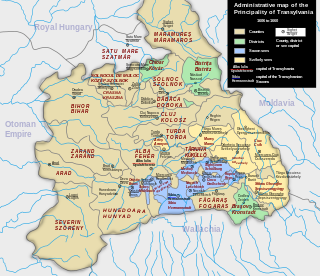
Esztergom County was an administrative county of the Kingdom of Hungary, situated on both sides of the Danube river. Its territory is now divided between Hungary and Slovakia. The territory to the north of the Danube is part of Slovakia, while the territory to the south of the Danube is part of Hungary.

Komárom county was an administrative county (comitatus) of the Kingdom of Hungary, situated on both sides of the Danube river. Today, the territory to the north of the Danube is part of Slovakia, while the territory to the south of the Danube is part of Hungary.

Syrmia County was a historic administrative subdivision (županija) of the Kingdom of Croatia-Slavonia. Croatia-Slavonia was an autonomous kingdom within the Lands of the Crown of Saint Stephen (Transleithania), the Hungarian part of Austria-Hungary. The region of Syrmia is today split between Croatia and Serbia. The capital of the county was Vukovar.

Varaždin County was an administrative subdivision (županija) of the Kingdom of Croatia-Slavonia. Croatia-Slavonia was an autonomous kingdom within the Lands of the Crown of Saint Stephen (Transleithania), the Hungarian part of the dual Austro-Hungarian Empire. Its territory is now in northern Croatia. The capital of the county was Varaždin.

The Kingdom of Bohemia, sometimes referenced in English literature as the Czech Kingdom, was a medieval and early modern monarchy in Central Europe. It was the predecessor state of the modern Czech Republic.

The Duchy of Bukovina was a constituent land of the Austrian Empire from 1849 and a Cisleithanian crown land of Austria-Hungary from 1867 until 1918.

Austrian Silesia, officially the Duchy of Upper and Lower Silesia, was an autonomous region of the Kingdom of Bohemia and the Habsburg monarchy. It is largely coterminous with the present-day region of Czech Silesia and was, historically, part of the larger Silesia region.

The Voivodeship of Serbia and Banat of Temeschwar or Serbian Voivodeship and the Banate of Temes, known simply as the Serbian Voivodeship, was a crownland of the Austrian Empire that existed between 1849 and 1861.

A district is a second-level division of the executive arm of the Austrian government. District offices are the primary point of contact between residents and the state for most acts of government that exceed municipal purview: marriage licenses, driver licenses, passports, assembly permits, hunting permits, or dealings with public health officers for example all involve interaction with the district administrative authority.

The Kingdom of Galicia and Lodomeria, a crown land of Austria-Hungary, was subdivided into political districts for administrative purposes, which were referred to in Polish as powiaty. When they were introduced in 1867 there were 74 of these administrative counties; in 1900 there were 78 counties. The administrative counties were responsible for storing vital records. These counties were introduced following the 1867 December Constitution.

Zala was an administrative county (comitatus) of the Kingdom of Hungary, bordered by the river Drave to the south. The territory of the former county is now divided between Hungary, Croatia and Slovenia. The capital of the county was Zalaegerszeg.

Kraszna county is a former administrative county of the Kingdom of Hungary along the river Kraszna; its territory is now in north-western Romania. Its capital cities were Krasznavár, Valkóvár and Szilágysomlyó.

Neusatz District was one of five administrative districts of the Voivodeship of Serbia and Banat of Temeschwar from 1850 to 1860. Its administrative center was Neusatz.

Zombor District was one of five administrative districts of the Voivodeship of Serbia and Temes Banat from 1850 to 1860. Its administrative center was Zombor.

Großbetschkerek District was one of five administrative districts of the Voivodeship of Serbia and Banat of Temeschwar from 1850 to 1860. Its administrative center was Großbetschkerek.
Szolnok County was a county in the Kingdom of Hungary between the 11th century and 1426. It was made up of two disconnected parts, one in what later became Transylvania and the Partium, the other around the Tisza centred on the settlement of Szolnok. The county was eventually split and became:

The Margraviate of Moravia was one of the Lands of the Bohemian Crown within the Holy Roman Empire and then Austria-Hungary, existing from 1182 to 1918. It was officially administered by a margrave in cooperation with a provincial diet. It was variously a de facto independent state, and also subject to the Duchy, later the Kingdom of Bohemia. It comprised the historical region called Moravia, which lies within the present-day Czech Republic.

The Bukovina District, also known as the Chernivtsi District, was an administrative division – a Kreis – of the Kingdom of Galicia and Lodomeria within the Habsburg monarchy in Bukovina, annexed from Moldavia. It was first a military district from 1775 to 1786 until it was officially incorporated into Galicia and Lodomeria as its own district.

Temesvár District was one of five administrative districts of the Voivodeship of Serbia and Banat of Temeschwar from 1851 to 1860. Its administrative centre was Temesvár, which was also the capital of the crown land. Following the 1854 reform Temesvár itself was directly subject to the crown land, and so separate from the district, while still acting as its capital.

Lugos District was one of five administrative districts of the Voivodeship of Serbia and Banat of Temeschwar from 1851 to 1860. Its administrative centre was Lugos.







![The Viertel
(Kreise
) of Austria (above and below the Enns) c. 1800. The Muhlkreis
is shown divided into Upper and Lower sections. The map also shows the County of Neuburg [de] in the north-west, which was not part of Austria. Neueste Karte des Erzherzogthums Oesterreich Ob und Unter der Enns.jpg](http://upload.wikimedia.org/wikipedia/commons/thumb/8/87/Neueste_Karte_des_Erzherzogthums_Oesterreich_Ob_und_Unter_der_Enns.jpg/220px-Neueste_Karte_des_Erzherzogthums_Oesterreich_Ob_und_Unter_der_Enns.jpg)
























